AUDI Q5 2016 Owners Manual
Manufacturer: AUDI, Model Year: 2016, Model line: Q5, Model: AUDI Q5 2016Pages: 300, PDF Size: 75.02 MB
Page 231 of 300
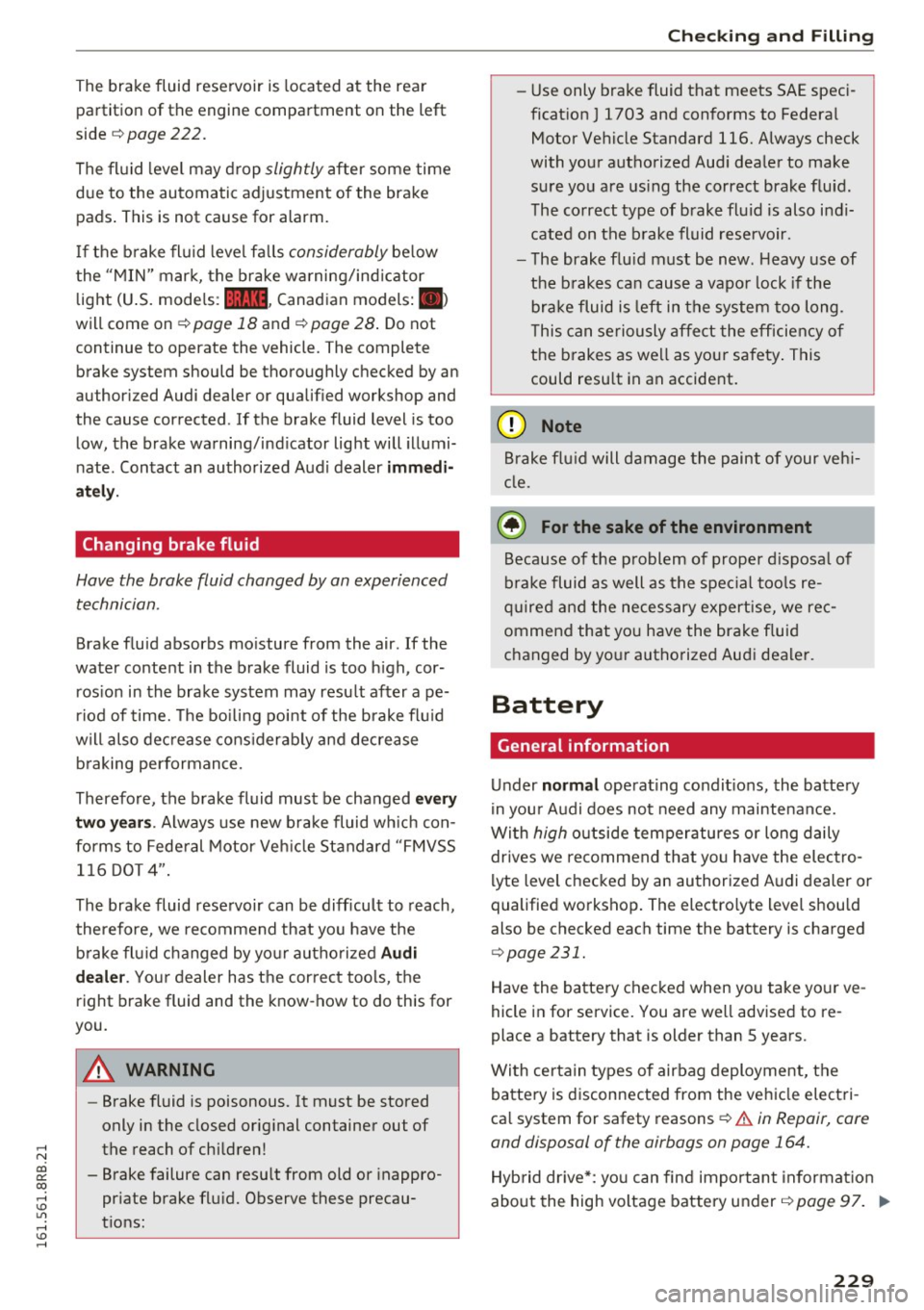
,....,
N
co
er::
co
,....,
partition of the engine compartment on the left
side ¢
page 222.
The fl uid level may drop slightly after some time
due to the automatic adjustment of the brake
pads . This is not cause for alarm.
I f the b rake fl uid level fa lls
considerably be low
the "MIN" mark, the brake wa rning/ind icator
light (U .S. mode ls:
1111 , Canadian models:.)
will come on¢
page 18 and ¢ page 28 . Do not
continue to operate the vehicle. The complete brake system should be thoroughly checked by an
author ized Audi dealer or qualified workshop and
the cause corrected . If the brake fluid level is too
low, the brake warning/ind icator light will illumi
nate. Contact an authorized Audi dealer
immedi
a te ly.
Changing brake fluid
Have the brake fluid changed by an experienced technician.
Brake fluid absorbs mo isture from the air. If the
water conte nt in the brake fluid is too h igh, cor
ros ion in the brake system may resu lt after ape
riod of time. The boiling poi nt of the brake flu id
will also dec rease cons iderably and decrease
braking pe rformance.
Therefore, the b rake fluid must be changed
e ve ry
two year s.
Always use new b rake fluid wh ich con
forms to Fede ral Motor Veh icle St andard "FMVSS
116 DOT 4".
The brake fluid reservoir can be diff icult to reach,
therefore, we re commend that yo u have the
b rake fl uid changed by yo ur autho rized
Audi
deal er.
Your dealer has the cor rect too ls, the
right brake fluid and the know -how to do this for
you.
A WARNING
- Brake fluid is poisonous. It must be stored
only in the closed original container out of
the reach of chi ldren!
- B rake failure can resu lt from old or inappro
pr iate brake flu id. Observe these precau
t io ns:
Ch eck ing and Filling
-Use only brake fluid that meets SAE speci
ficat ion
J 1703 and conforms to Federal
Motor Vehicle Standard 116. Always check
with your authorized Aud i dealer to make
sure you are us ing the correct brake fluid .
The co rrect type of brake flu id is also i ndi
cated on the b rake fluid reservoir.
- The brake flu id must be new. Heavy use of
the b rakes can cause a vapo r lock if the
bra ke fluid is left in the system too long.
T his can se riously affe ct the efficiency of
t h e b rakes as we ll as you r safety . This
could resu lt in an accident.
(D Note
B rake flu id will damage the paint of your ve h i
cle.
@) For the sake of the environment
Because of the p roblem of proper d isposa l of
brake fluid as well as the spec ial too ls re
q uire d and the necessary expertise, we rec
ommend that yo u have the bra ke fluid
c hanged by yo ur authorize d Au di dealer.
Battery
General information
Under normal ope rat ing condit ions, the batte ry
in you r A udi does not need any mainte nance.
Wi th
high o utside temperatures or long daily
drives we recommend that yo u have the elec tro
lyte level checked by an authorized A udi dealer or
qualified workshop . The electro lyte level should
also be checked each time the battery is charged
~ page 231.
Have the batte ry checked when you take your ve
hicle in for service. You are we ll advised to re
place a battery that is older than S years.
Wi th certain types of airbag deployment, the
battery is d isconnected from the veh icle electri
ca l system for safety reasons¢.&.
in Repair, care
and disposal of the airbags on page 164.
Hyb rid dr ive *: yo u can find impo rtant informat ion
about the high voltage battery under ¢
page 97. .,.
229
Page 232 of 300
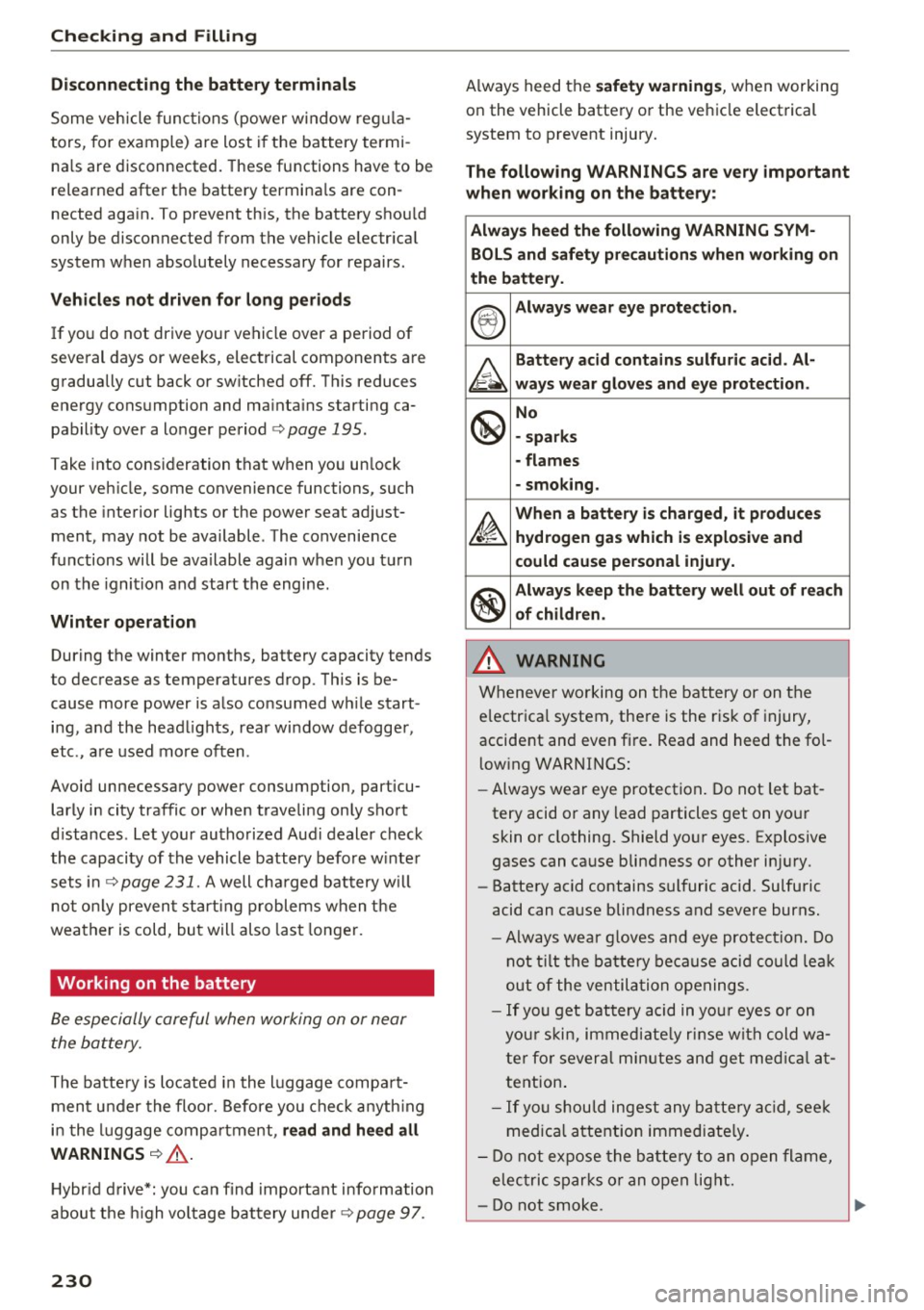
Checking and Filling
Disconnecting the battery terminals
Some vehicle functions (power window regula
tors, for example) are lost if the battery termi
na ls are disconnected. These functions have to be
relearned after the battery terminals are con
nected again. To prevent this, the battery should
only be disconnected from the vehicle e lectrical
system when absolutely necessary for repairs.
Vehicles not driven for long periods
If you do not drive your vehicle over a period of
several days or weeks, electrical components are
gradually cut back or sw itched off. This reduces
energy consumption and ma intains starting ca
pab ility over a longer period
c::> page 195 .
Take into consideration that when you unlock
your veh icle, some convenience functions, such
as the interior lights or the power seat adjust
ment, may not be available. The convenience
functions will be available again when you turn
on the ignition and start the engine.
Winter operation
During the winter months, battery capacity tends
to decrease as temperatures drop. This is be
cause more power is also consumed while start
ing, and the head lights, rear window defogger,
etc., are used more often.
Avoid unnecessary power consumption, particu
larly in city traffic or when traveling only short
d istances . Let your authorized Audi dealer check
the capacity of the vehicle battery befo re winter
sets inc::>
page 231. A well cha rged battery w ill
not only preven t starting problems when the
weather is cold, but will also last longer.
Working on the battery
Be especially careful when working on or near
the battery.
The batte ry is located in the luggage compart
ment under the floor. Before you check anything
in the luggage compartment,
read and heed all
WARNINGS
c::> & .
Hybr id drive*: you can find important information
about the high volta ge battery unde r
c::> page 97.
230
Always heed the safety warnings , when working
on the vehicle battery or the vehicle electrical system to prevent injury.
The following WARNINGS are very important
when working on the battery :
Always heed the following WARNING SYM· BOLS and safety precautions when working on
the battery .
®
Always wear eye protection .
A
Battery acid contains sulfuric acid. Al-
ways wear gloves and eye protection .
@
No
• sparks
• flames
- smoking.
~
When a battery is charged, it produces
hydrogen gas which is explosive and
could cause personal injury.
®
Always keep the battery well out of reach
of children .
.b WARNING
-
Whenever working on the battery or on the
e lectrica l system, there is the risk of injury,
accident and even fire. Read and heed the fol
lowing WARNINGS:
- Always wear eye protection . Do not let bat
tery acid or any lead particles get on your
skin or clothing. Shield your eyes. Explosive
gases can cause blindness or other injury.
- Battery acid contains sulfuric acid. Sulfuric
acid can cause blindness and severe burns.
-A lways wear glo ves and eye protection. Do
not tilt the battery because acid could leak
out of the ventilation openings.
- If you get battery acid in yo ur eyes or on
you r skin, immediate ly rinse with cold wa
ter for several minutes and get medical at
tention .
- If you should ingest any battery acid , seek
medical attention immediate ly.
- Do not expose the battery to an open flame,
elec tric sparks or an open light.
- Do not smoke.
~
Page 233 of 300
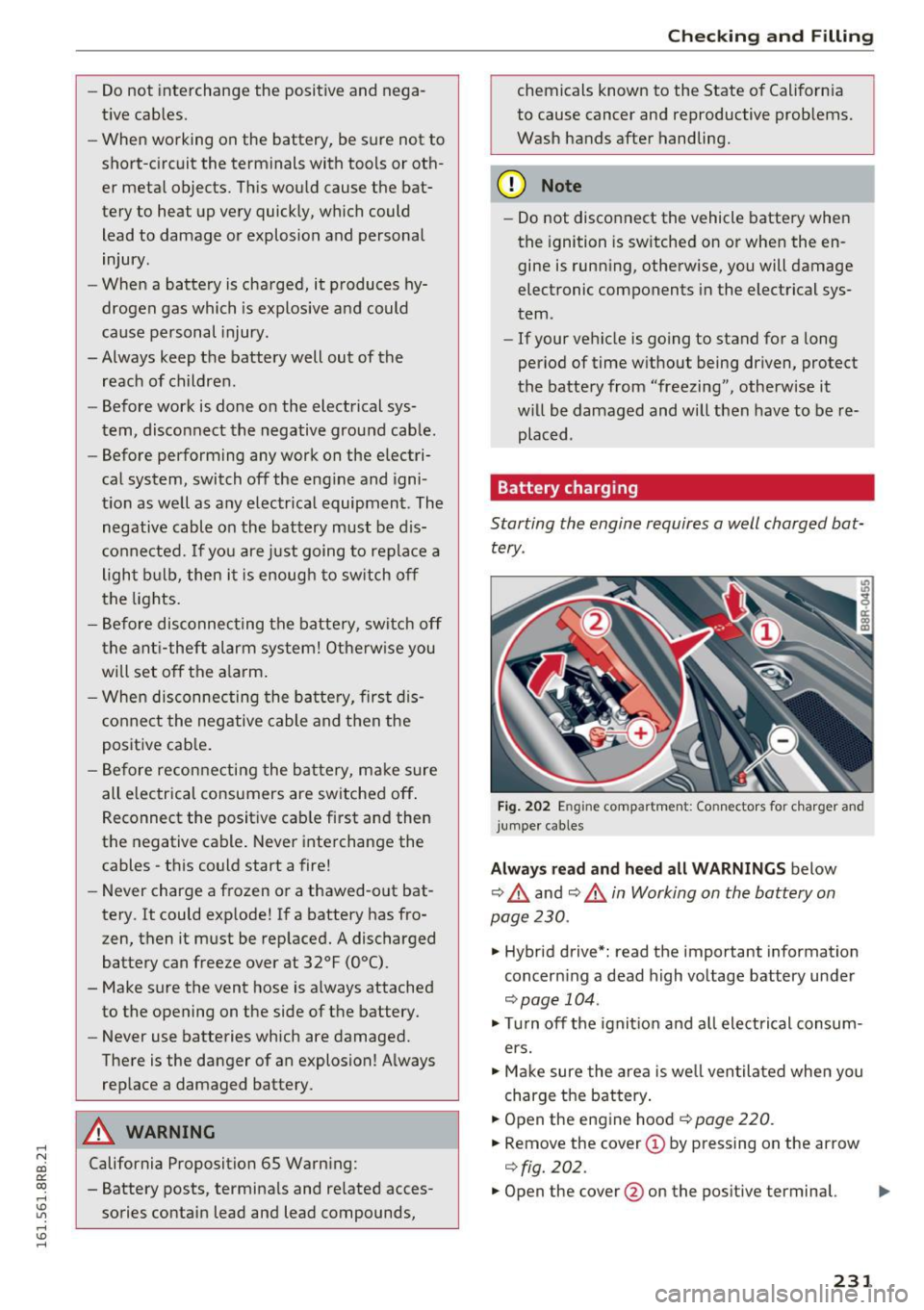
..... N
co ~ CX)
..... I.Cl U"I
..... I.Cl .....
-Do not interchange the positive a nd nega
tive cables.
- When working on the battery, be sure not to
short-circuit the terminals with tools or oth
er metal objects. This would cause the bat
tery to heat up very quickly, which could
lead to damage or explosion and personal
injury.
- When a battery is charged, it produces hy
drogen gas which is explosive and could
cause personal injury.
- Always keep the battery well out of the reach of children.
- Before work is done on the electrical sys
tem, disconnect the negative ground cable.
- Before performing any work on the electri
cal system, switch off the engine and igni
tion as well as any electrical equipment. The
negative cable on the battery must be dis
connected. If you are just going to replace a
light b ulb, then it is enough to sw itch off
the lights.
- Before disconnecting the battery, switch off
the ant i-theft alarm system! Otherw ise you
will set off the a larm.
- When disconnecting the batte ry, first dis
connect the negative cable and then the
positive cab le.
- Before reconnecting the battery, make sure
all e lectrical consumers are switched off .
Reconnect the posit ive cable first and then
the negative cable . Never interchange the
cables -this could start a fire!
- Never charge a frozen or a thawed-out bat
tery. It could exp lode! If a battery has fro
zen, then it must be replaced. A discharged
battery can freeze over at 32°F (0°C).
- Make sure the vent hose is a lways attached
to the opening on the side of the battery.
- Never use batteries which are damaged.
There is the danger of an explosion! Always replace a damaged battery.
A WARNING
California Proposition 65 Warn ing:
- Battery posts, termina ls and re lated acces
sories contain lead and lead compounds,
C hecki ng an d Fill in g
chemicals known to the State of Californ ia
to cause cancer and reproductive prob lems.
Wash hands after handling.
(D Note
- Do not disconnect the vehicle battery when
the ignition is sw itched on or when the en
gine is running, otherwise, you will damage
electronic components in the electrical sys
tem .
- If your vehicle is going to stand for a long
period of time w ithout being driven, protect
the battery from "freezing", otherwise it
w ill be damaged and will then have to be re
placed .
Battery charging
Starting the engine requires a well charged bat
tery .
Fig . 202 E ngine compar tmen t: Co nn ectors fo r charg er and
j umpe r cables
Alw ays re ad and heed a ll WARN IN GS below
c;, ,& and r=;, .& in Working on the battery on
page 230 .
., Hybrid drive*: read the important information
concern ing a dead high voltage battery under
¢ page 104 .
., Turn off the ignition and a ll electrical consum
ers.
... Make sure the area is we ll ven tilated when you
charge the battery .
... Open the eng ine hood
r=;, page 220 .
... Remove the cover (D by pressing on the arrow
¢ fig. 202 .
... Open the cover @on the pos itive terminal. ..,_
231
Page 234 of 300
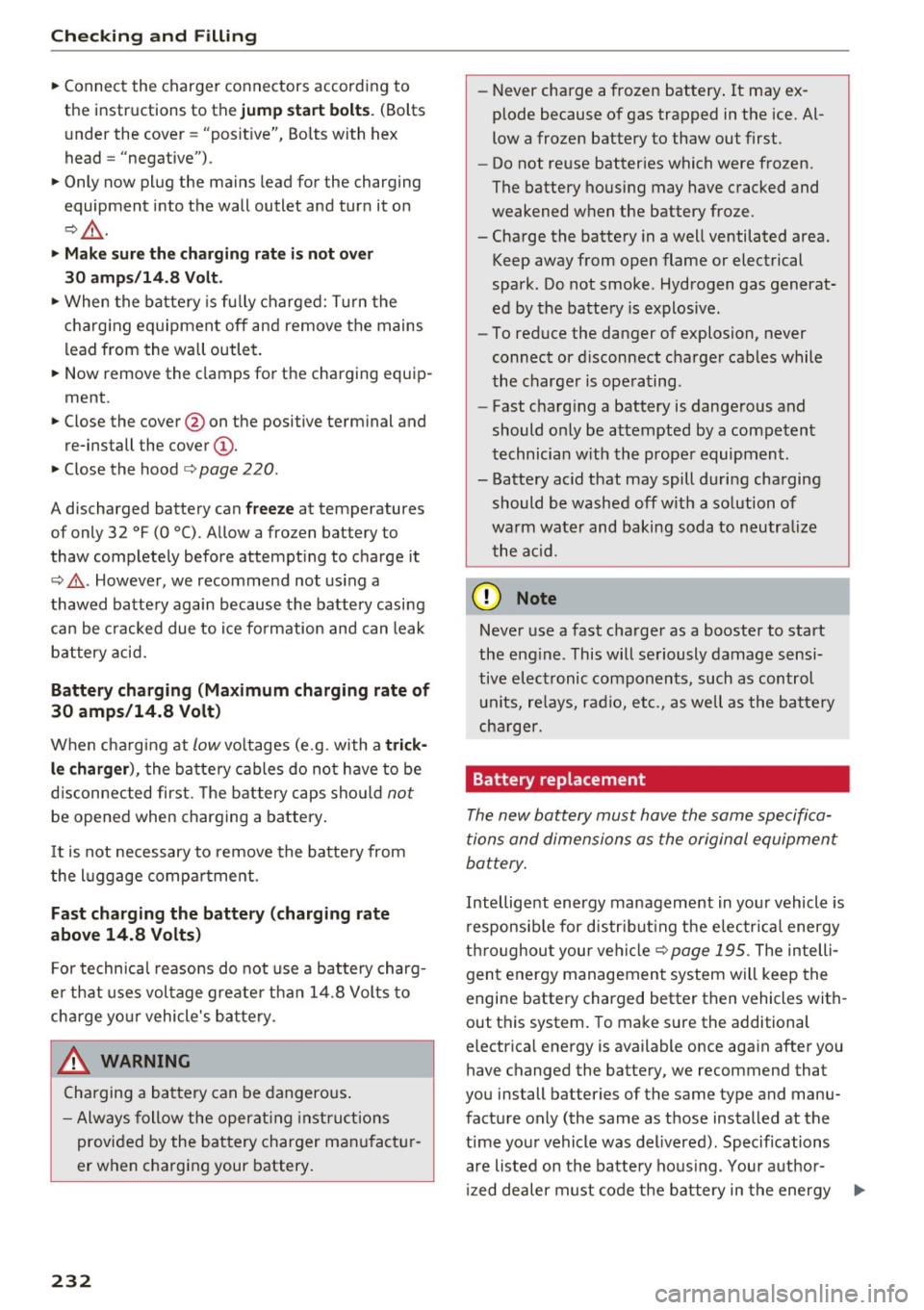
Check ing and F illing
"' Connect the charger connectors according to
the instr uctions to the
jump start bolts . (Bolts
u nder the cover = "posit ive", Bo lts with hex
head = "negative") .
"' Only now plug the mains lead for the charging
equipment into the wall outlet and tur n it on
¢& .
"' Make sure the charging rate is not over
30 amp s/14 .8 Volt.
"' When the batte ry is fu lly charged: T urn the
charg ing equipment off and remove the mains
lead from the wall outlet .
"' Now remove the clamps for the charg ing equip
ment .
"' Close the cover @on the positive term inal and
re-install the cover@.
"' Close the hood
c:::;, page 220 .
A discharged battery can freeze at temperatures
of only 32 °F (0 °C). Allow a frozen battery to
thaw completely before attempt ing to charge it
c:::;, ,& . However, we recommend not us ing a
thawed batte ry again because the battery casi ng
can be cracked due to ice fo rmation and can leak
b attery acid.
Battery charging (Maximum charging rate of
30 amps/14.8 Volt)
W hen cha rging at low vo ltages (e .g . with a trick
le charger ),
the ba tte ry cables do not h ave to be
d isconnected first. The b att ery caps sho uld
no t
be opened when charging a battery.
It is not necessary to remove the batte ry from
the l uggage comp artme nt.
Fast charging the battery (charging rate
above 14.8 Volts)
F or techn ica l reaso ns do not use a battery charg
er that uses vol tage greate r th an 14.8 Volts to
charge yo ur vehicle's bat tery.
A WARNING
Charging a ba ttery can be dangerous .
- Alw ays foll ow the operat ing instru ctions
p rovi ded by the bat tery char ger m anuf actur
er when c harging your battery .
232
-Never cha rge a frozen battery . It may ex
plode because of gas trapped in the ice. Al
low a frozen battery to thaw out first.
- Do not reuse batter ies which were f rozen.
The battery housing may have cracked and
weakened w hen the battery froze.
- Charge the battery in a well ventilated area.
Keep away from open flame or electrical
spark. Do not smoke . Hydrogen gas generat
ed by the battery is explosive.
- To reduce the da nger of explosion, never
connect or d isconnect c harger cables while
the charge r is ope ra ting .
- Fast c harg ing a battery is dange rous and
should o nly be attempted by a compe ten t
t echnicia n w ith the prope r equipment .
- Battery acid that may spill duri ng charging
should be washed off w it h a so lution o f
warm water and baking soda to neutra lize
t he a cid.
(D Note
Neve r use a fast c harge r as a booster to start
the eng ine . This will seriously damage se nsi
tive electronic components, such as cont rol
units, re la ys, ra d io, e tc., as well as the batte ry
c h ar ger.
Battery replacement
The new battery must have the same specifica
tions and dimensions as the original equipmen t
battery.
Intelligent energy manageme nt in yo ur vehicle is
r esponsib le for d istr ib uting t he e lec trica l energy
t hr oughou t your ve hicl e
c:::;, page 195 . The intelli
gen t energy management system w ill keep the
engine battery charged bette r then vehicles with
out this system . To make sure the additional
e lectrica l ene rgy is available once aga in after you
have changed the batte ry, we recommend that
you install batteries of the same type and manu
facture only (the same as those installed at the
time yo ur vehicle was delivered) . Specifications
a re listed on the ba tte ry ho using . Your a uth or-
iz ed dealer m ust code the battery in the energy
9"'
Page 235 of 300
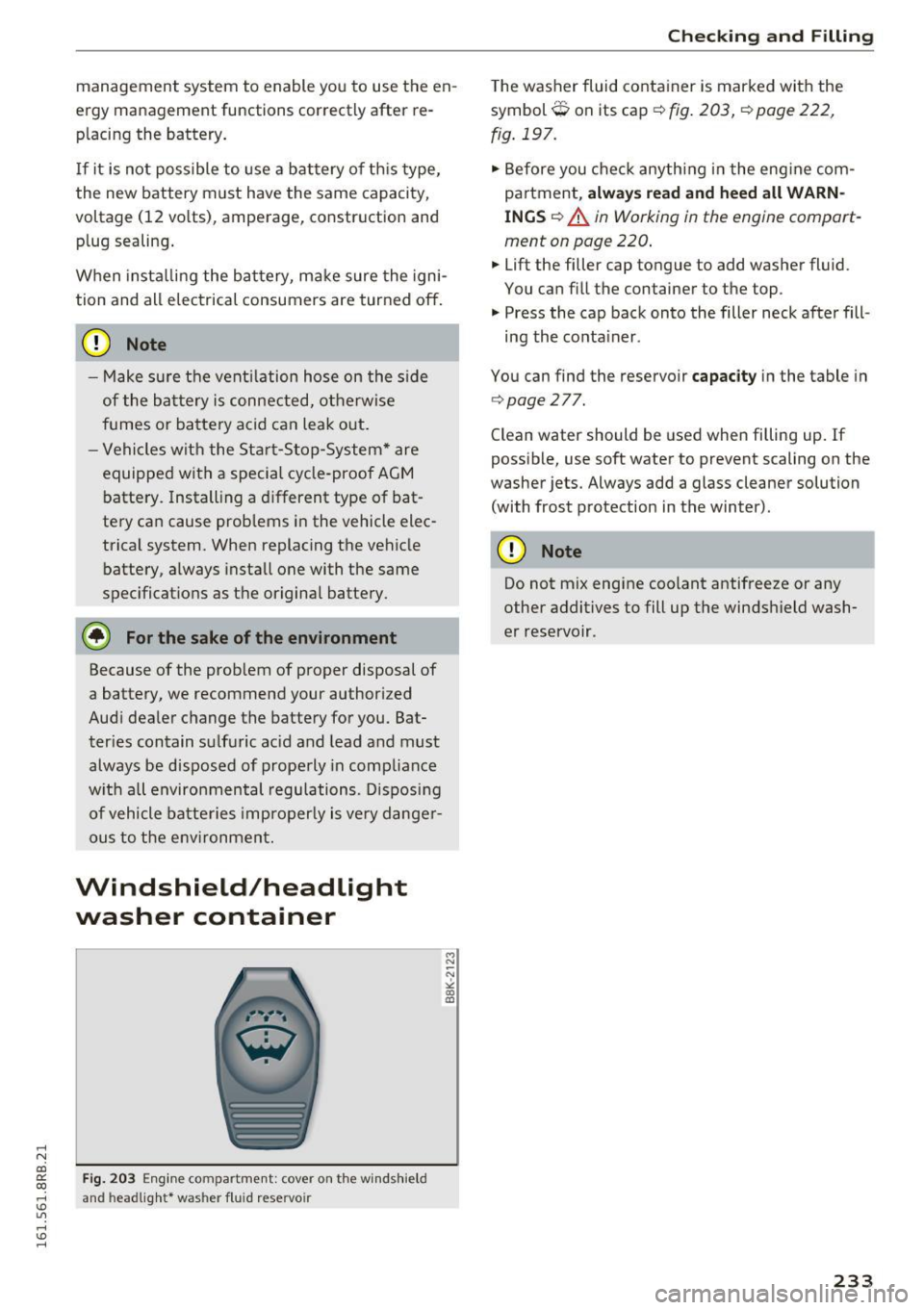
,...,
N
co ~ CX) ,...,
I.Cl U"I ,...,
I.Cl ,...,
management system to enable you to use the en
ergy management functions correctly after re
placing the battery.
If it is not possible to use a battery of this type,
the new battery must have the same capacity,
voltage (12 volts), amperage, construction and
plug sealing .
When installing the battery, make sure the igni
tion and all electrical consumers are turned off.
CD Note
- Make sure the vent ilation hose on the side
of the battery is connected, otherwise
fumes or battery acid can leak out.
- Vehicles with the Start-Stop-System* are
equipped with a special cycle-proof AGM
battery. Installing a different type of bat
tery can cause prob lems in the vehicle elec
trical system. When replacing the vehicle battery, always install one with the same
spec ifications as the original battery.
@) For the sake of the environment
Because of the problem of proper disposal of
a battery, we recommend your authorized
Audi dealer change the battery for you. Bat
ter ies contain sulfuric acid and lead and must
always be disposed of properly in compliance
with all environmental regulations. Disposing
of vehicle batteries imp roperly is very danger
ous to the environment.
Windshield/headlight
washer container
Fig. 203 Engine compartment: cover on the windshield
and headl ight* washer flu id reservo ir
M N
-N
"' CX) CX)
Checking and Filling
The washer fluid container is marked with the
symbol
O on its cap ¢ fig. 203, ¢page 222,
fig. 197 .
.. Before you check anything in the engine com
pa rtment,
always read and heed all WARN
INGS ¢ A in Working in the engine compart
ment on page 220 .
.. Lift the filler cap tongue to add washer fluid .
You can fill the container to the top .
.,. Press the cap back onto the filler neck after fill-
ing the co nta iner.
You can find the reservoir
capacity in the table in
¢page 277.
Clean water should be used when filling up. If
possible, use soft water to prevent scaling on the
washer jets. Always add a glass cleaner solution
(with frost protection in the winter).
CD Note
Do not mix engine coolant antifreeze or any
other additives to fill up the windshield wash er reservoir .
233
Page 236 of 300
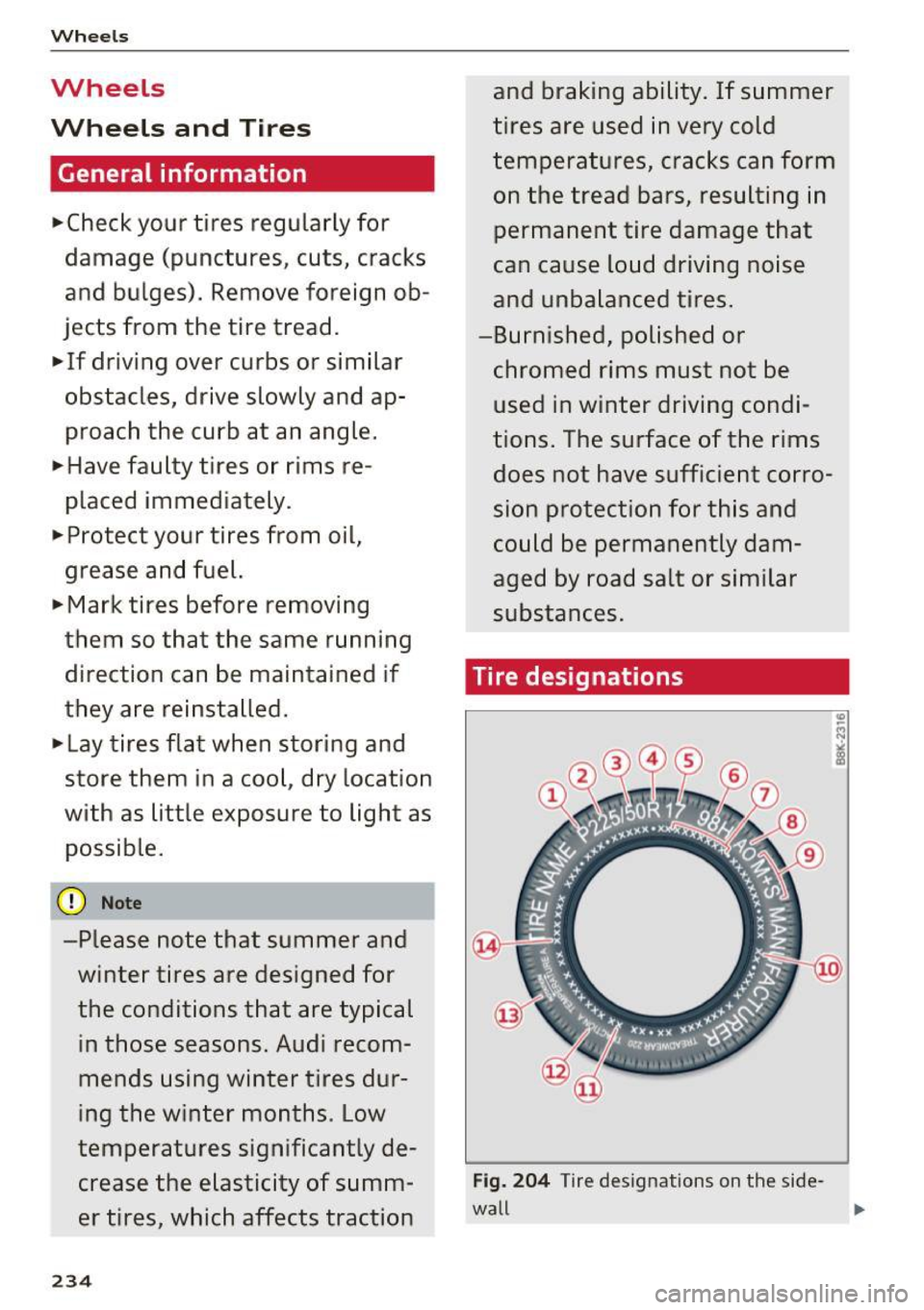
Wheels
Wheels
Wheels and Ti res
General information
.,. Check your tires regularly for
damage (punctures, cuts, cracks
and bulges). Remove foreign ob
jects from the tire tread.
.,. If driving over curbs or similar
obstacles, drive slowly and ap proach the curb at an angle.
.,.Have faulty tires or rims re
placed immediately.
.,.Protect your tires from oil,
grease and fuel.
.,.Mark tires before removing
them so that the same running
direction can be maintained if
they are reinstalled .
.,. Lay tires flat when storing and
store them in a cool, dry location
with as little exposure to light as
possible.
(D N ote
-Please note that summer and
winter tires are designed for
the conditions that are typical in those seasons . Audi recom
mends using winter tires dur
ing the winter months . Low
temperatures significantly de crease the elasticity of summ
er tires, which affects traction
23 4
and b raking ability. If summer
tires are used in very cold
temperatures, cracks can form
on the tread bars, resulting in permanent tire damage that
can cause loud driving noise
and unbalanced tires.
-Burnished, polished or chromed rims must not be used in winter driving condi
tions. The surface of the rims
does not have sufficient corro
sion protection for this and
could be permanently dam
aged by road salt or similar
substances.
Tire designations
F ig. 20 4 Tire des ignat ions on the side-
wall II>
Page 237 of 300
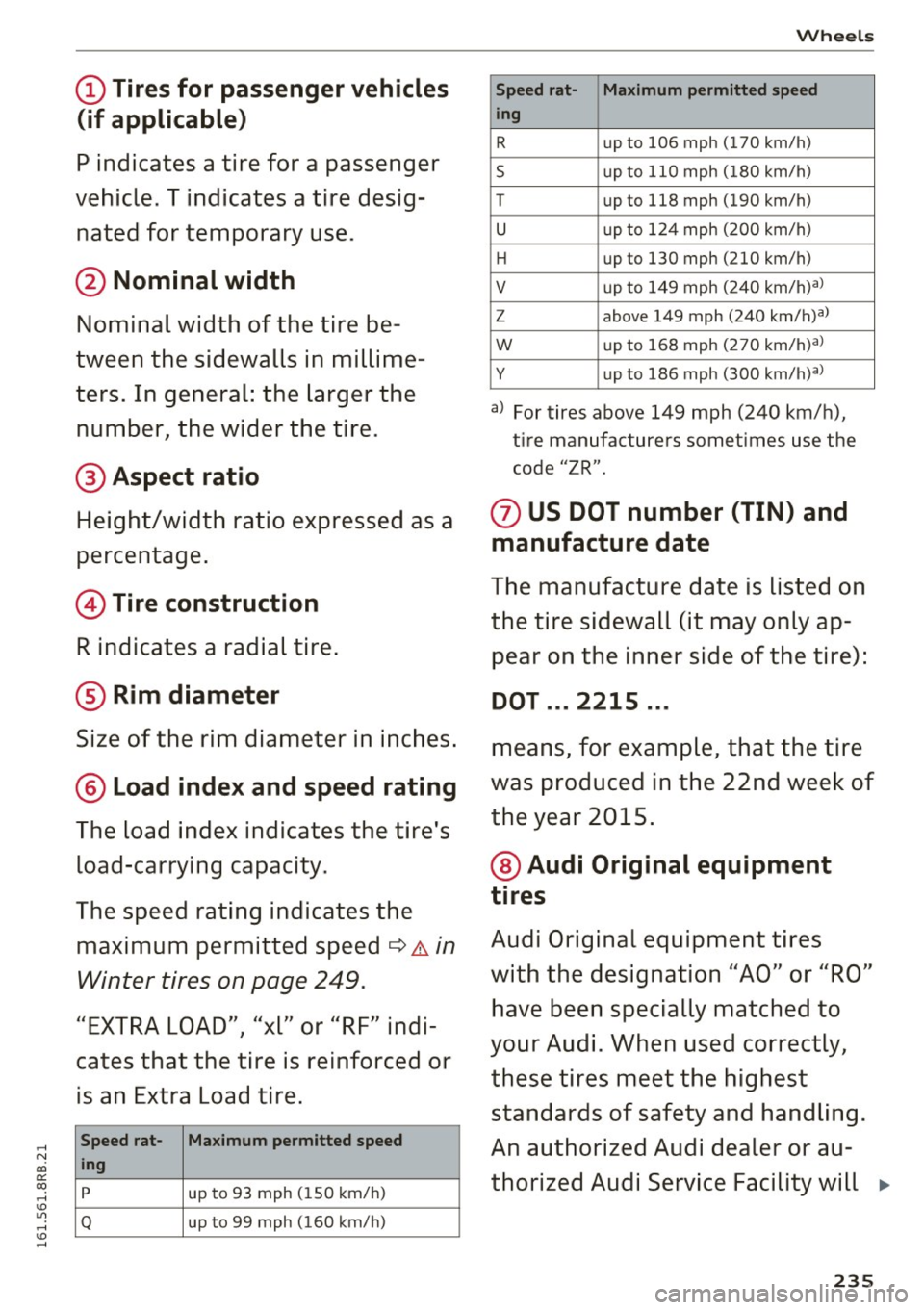
.... N
co
er::
co
....
(if applicable)
P indicates a tire for a passenger
vehicle. T indicates a tire desig
nated for temporary use.
@ Nominal width
Nominal width of the tire be
tween the sidewalls in millime
ters. In general: the larger the
number, the wider the tire.
@ Aspect ratio
Height/width ratio expressed as a
percentage.
@ Tire construction
R indicates a radial tire.
® Rim diameter
Size of the rim diameter in inches.
@ Load index and speed rating
The load index indicates the tire's
load-carrying capacity.
The speed rating indicates the
maximum permitted speed¢.&
in
Winter tires on page 249.
"EXTRA LOAD", "xl" or "RF" indi
cates that the tire is reinforced or
is an Extra Load tire.
Speed rat-
Maximum permitted speed
ing
p
up to 93 mph (150 km/h)
Q up to 99 mph (160 km/h)
Wheels
Speed rat- Maximum permitted speed
ing
R up to 106 mph (170 km/h)
s up to 110 mph (180 km/h)
T up to 118 mph (190 km/h)
u up to 124 mph (200 km/h)
H up to 130 mph (210 km/h)
V up to 149 mph (240 km/h) al
z above 149 mph (240 km/h)al
w up to 168 mph (270 km/h)al
y up to 186 mph (300 km/h)al
a) For tires above 149 mph (240 km/h),
tire manufacturers sometimes use the
code "ZR".
(j) US DOT number (TIN) and
manufacture date
The manufacture date is listed on
the tire sidewall (it may only ap
pear on the inner side of the tire):
DOT ... 2215 ...
means, for example, that the tire
was produced in the 22nd week of
the year 2015.
@ Audi Original equipment
tires
Audi Original equipment tires
with the designation "AO" or "RO" have been specially matched to
your Audi. When used correctly,
these tires meet the highest
standards of safety and handling.
An authorized Audi dealer or au
thorized Audi Service Facility will ""
235
Page 238 of 300
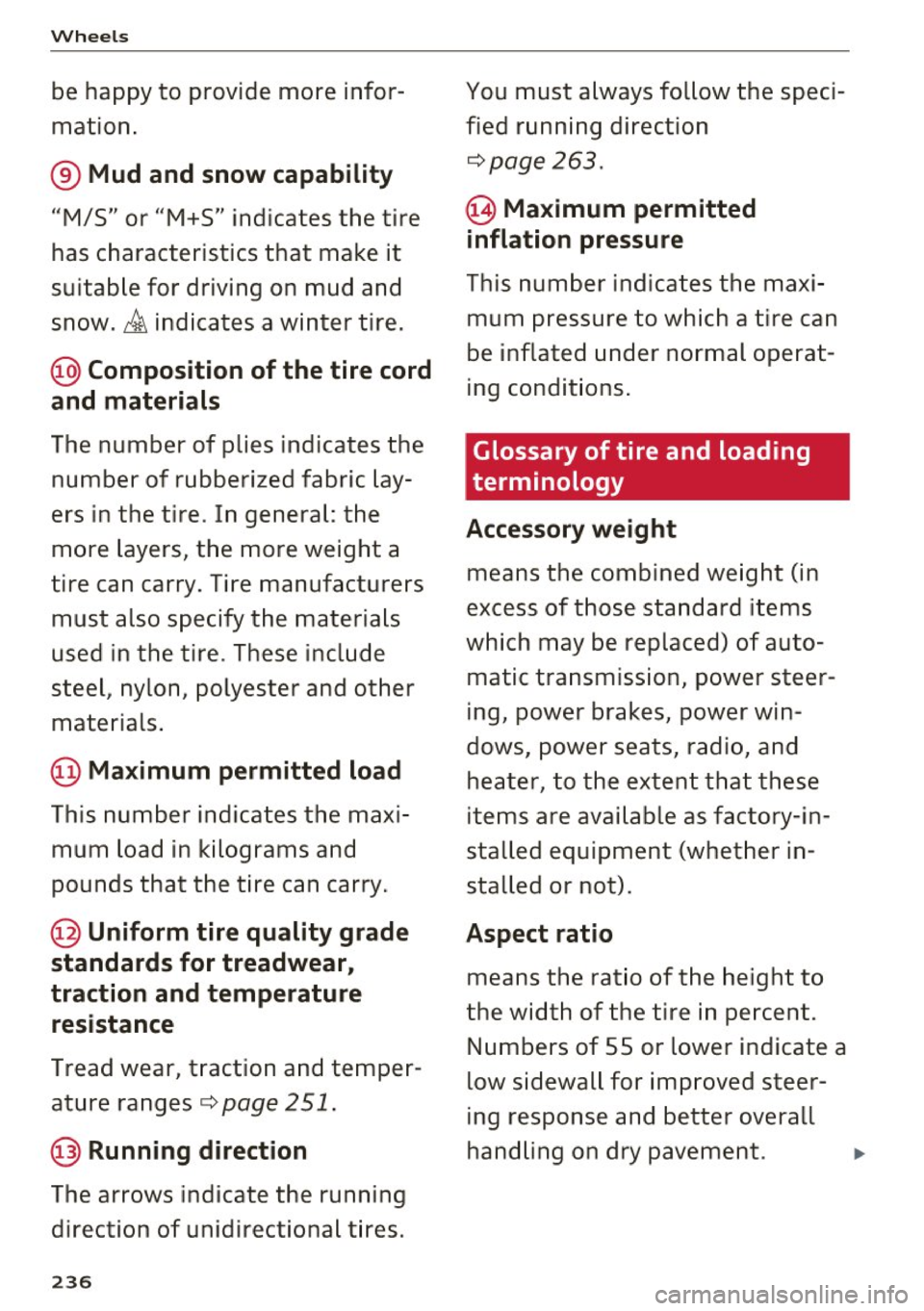
Wheels
be happy to provide more infor
mation.
® Mud and snow capability
"M/S" or "M+S" indicates the tire
has characteristics that make it
suitab le for driving on mud and
snow.
& indicates a winter t ire.
@ Compos ition of the tire cord
and materials
The number of plies indicates the
number of rubberized fabric lay
ers in the tire . In general: the
more layers, the more weight a
tire can carry. Tire manufacturers must also specify the materia ls
used in the tire. These include
steel, nylon, polyester and other
materials .
@ Maximum permitted load
This number indicates the maxi
mum load in k ilograms and
pounds that the tire can carry.
@ Uniform tire quality grade
standards for treadwear,
traction and temperature
resistance
Tread wear, t raction and temper
ature ranges
¢ page 251 .
@ Running direction
The arrows indicate the running
direction of unidirec tiona l tires.
23 6
You must a lways follow the speci
fied runn ing direction
¢ page 263.
@ Maximum permitted
inflation pressure
This number indicates the maxi
mum pressure to which a tire can be inflated unde r normal operat
ing condit ions .
Glossary of tire and loading
terminology
Accessory weight
means the comb ined we ight (in
excess of those standard items
which may be replaced) o f auto
matic tra nsmission , power steer
ing , power brakes , power wi n
dows, power seats , radio , and
heater, to the extent that these
items a re available as facto ry-in
stalled equipment (whet her in
stalled or not).
Aspect ratio
means the rat io of the height to
the width o f the tire in pe rcent.
Numbe rs of 55 or lower indicate a
low sidewa ll for imp roved steer
ing response and better overa ll
handling on dry pavement .
...
Page 239 of 300
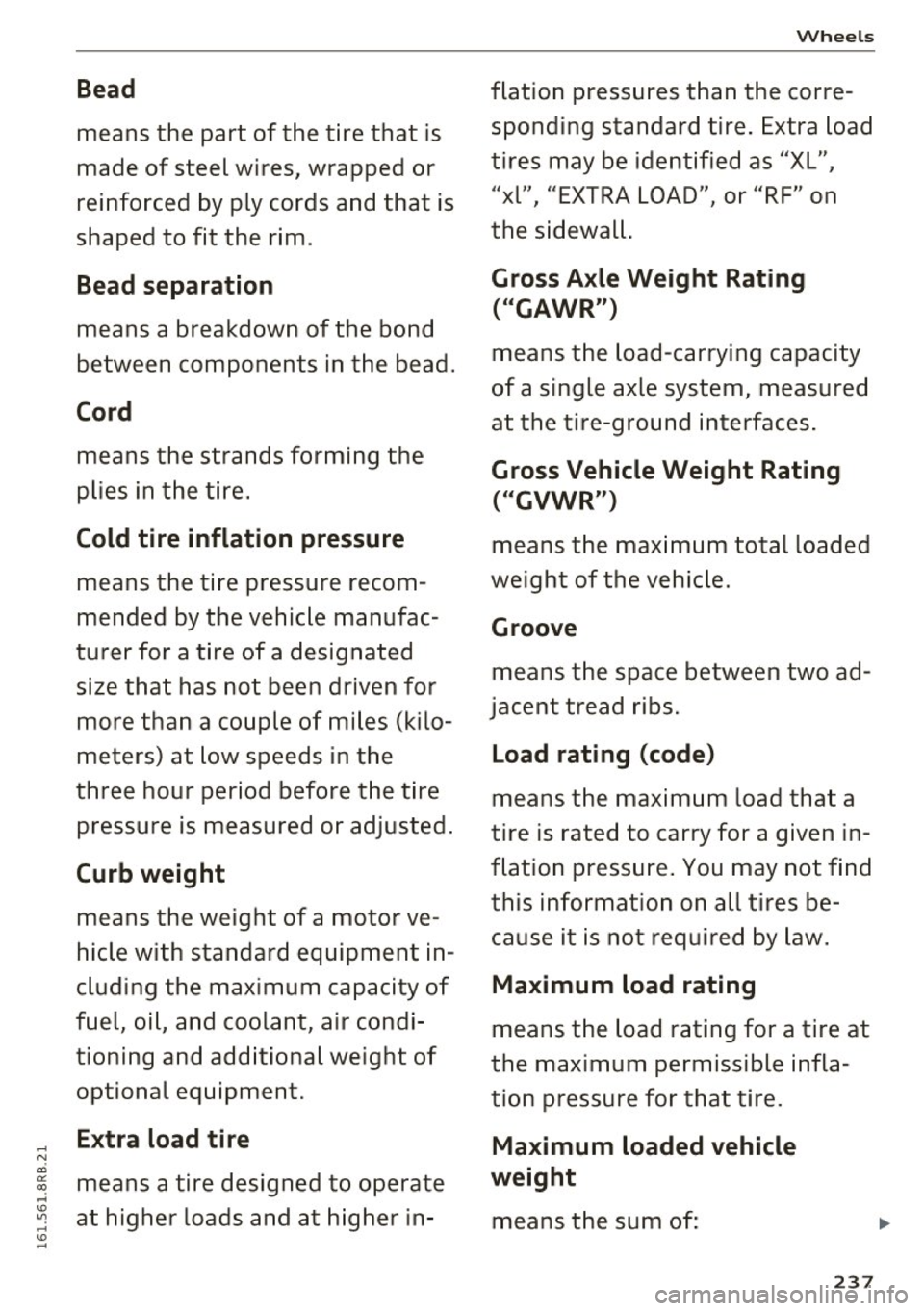
Bead
means the part of the tire that is
made of steel wires, wrapped or
reinforced by ply cords and that is
shaped to fit the rim.
Bead separation
means a breakdown of the bond
between components in the bead.
Cord
means the strands forming the
plies in the tire.
Cold tire inflation pressure
means the tir e pressure recom
mended by the vehic le manufac
turer for a tire of a designated
size that has not been driven for
more than a couple of miles (kilo
meters) at low speeds in the
three hour period before the tire pressure is measured or adjusted .
Curb weight
means the weight of a motor ve
hicle with standard equipment in
c luding the maximum capacity of
fuel, oi l, and coolant, a ir condi
tioning and add itional weight of
optional equipment.
E xtra load ti re
means a tire designed to operate
at higher loads and at h igher in -
Wheels
flation pressures than the corre
sponding standard tire . Extra load
tires may be identified as "XL",
" xl", "EXTRA LOAD", o r "RF" on
the sidewal l.
Gross Axle Weight Rating
( " GAWR")
means the load -carrying capacity
of a single axle system, measured
at the tire-ground interfaces .
Gross Vehicle Weight Rating
("GVWR ")
means the max imum total loaded
weight of the vehic le.
Groove
means the space between two ad
jacent tr ead ribs .
Load rating (code)
means the max im um load tha t a
tire is rated to carry fo r a g iven in
flat ion pressure . You may not find
this informat ion on all tires be
cause it is not requ ired by law.
Maximum load rating
means the load rating for a tire at
the maximum pe rmissible infla
tion pressure for that tire.
Maximum loaded vehicle
weight
means the sum o f:
23 7
..
Page 240 of 300
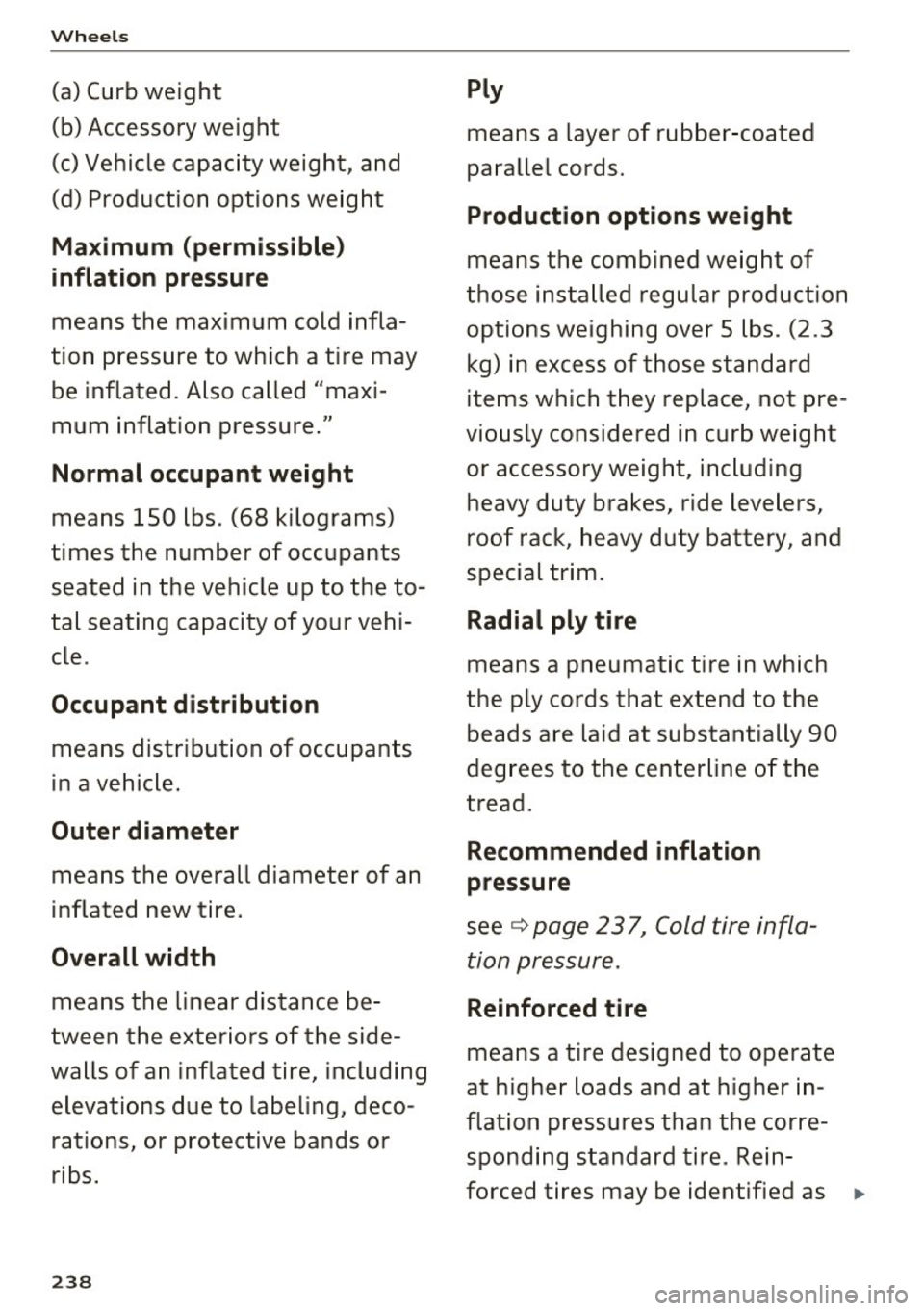
Wheels
(a) Curb weight
(b) Accessory weight
(c) Vehicle capacity weight, and
(d) Production options weight
Maximum (permissible )
inflation pressure
means the maximum cold infla
tion pressure to which a tire may be inflated. Also called "maxi
mum inflation pressure ."
Normal occupant weight
means 150 lbs . (68 kilograms)
times the number of occupants
seated in the vehicle up to the to
ta l seating capacity of your vehi
c le .
Occupant distribution
means distribut ion of occupan ts
in a vehic le .
Outer diameter
means the overall diamete r of an
inflated new tire.
Overall width
means the l inear distance be
tween the exter iors of the side
walls of an infla ted tire , including
elevations due to labeling , deco
rations, or protective bands or
r ibs.
23 8
Ply
means a layer of rubber -coated
pa rallel cords.
Production options weight
means t he comb ined we ight of
those insta lled regular production
options weighing over 5 lbs . (2 .3
kg) in excess of those standard
items which they replace , not pre
viously considered in curb weight or accessory weight, inc luding
heavy duty brakes, ride levelers,
roof rack, heavy duty battery, and
special trim.
Radial ply tire
means a pneumatic tire in which
the ply co rds that extend to the
beads are laid at subs tantially 90
deg rees to the centerline o f the
tread .
Recommended inflation
pressure
see~ page 23 7, Cold tire infla
tion pressure.
Reinforced tire
means a tire designed to operate
at highe r loads and at h igher in
flat ion pressures than t he corre
spond ing standa rd tire . R ein
forced tires may be identified as .,.